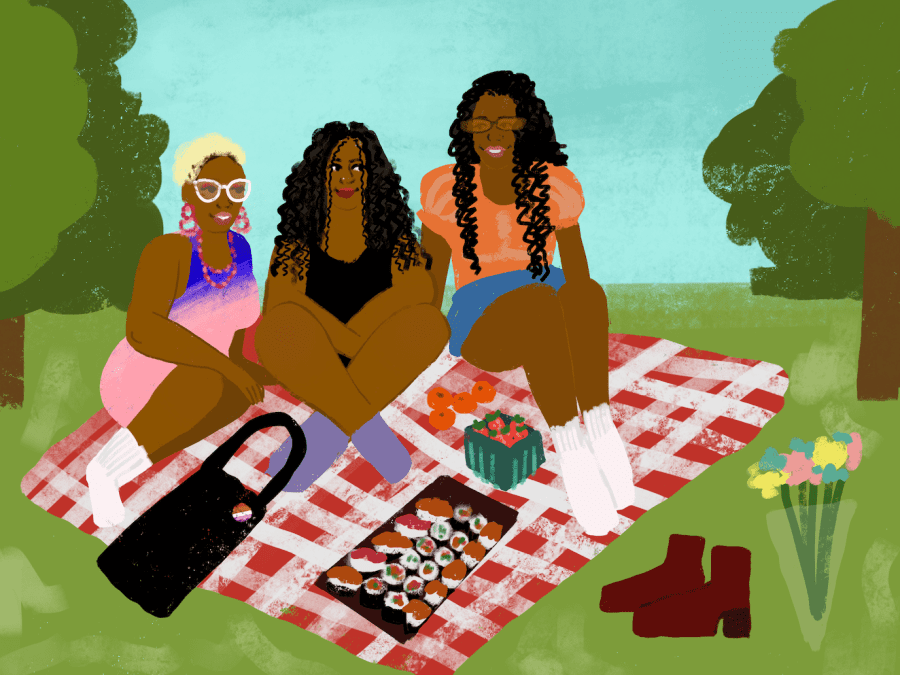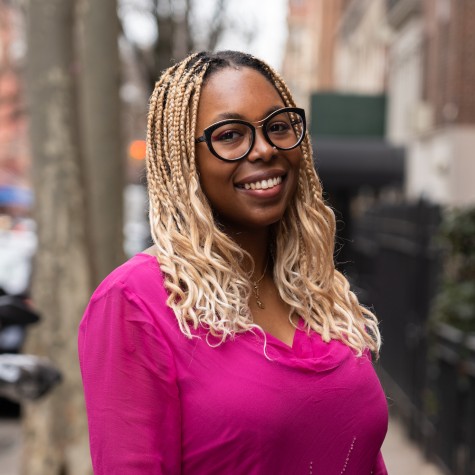How to be gay during the day: Building lesbian community in the city
Read this before you go to Cubbyhole for the third time this weekend.
(Illustration by Susan Behrends Valenzuela)
December 1, 2022
Finding a lesbian community at NYU is simultaneously my greatest challenge and my greatest feat. At a school with a large LGBTQ+ population, you’d be surprised at the lengths I’ve gone to find queer affinity spaces. I delved into my queer identity during college — I ended my freshman year as a bisexual Black woman and started my sophomore year as a Black nonbinary lesbian. It took me months to say out loud that I identify as a lesbian, and it took a year for me to find a lesbian community that accepts me for who I am.
However, you won’t find me bouncing between Cubbyhole and Henrietta Hudson; in fact, my favorite spot in the West Village is my partner’s apartment. A perfect night for me is when I’m in bed before midnight. From birdwatching to bookstores, you’re not alone in craving queer spaces outside of nightlife. I’m here to show love to my daytime gays: the ones who like bottomless brunch at noon and being home before the sun goes down, or the ones who find that the safest places to be queer are local parks, cafes and smaller affinity spaces.
Finding other queer people who share your interests is a terrific place to start. For example, building lesbian community around sports — an activity traditionally dominated by cisgender heterosexual men — can be very affirming. Steinhardt junior Maelys Monga got involved with a queer skateboarding group after meeting people at Washington Square Park.
“I’d been skateboarding since I was 11,” Monga said. “I found out about these skate meetups. I got to those and they were beautiful — it was nice being in a space where everyone is helping each other out and just down to meet other people.”
Utilizing public green spaces is another option to meet queer people outside of clubs. Steinhardt graduate student and researcher Sasha Karbachinskiy enjoys connecting with fellow transgender women and transfeminine people in her community.
“There’s also things like Trans [Ladies] Picnic which happens once a month — you’ll get like a hundred girls there which is amazing,” Karbachinskiy said. “You’ll seize it because there are different circles and you’ll meet people you didn’t know which is awesome. It’s the perfect breeding ground for people to meet each other and hook up.”
The first step in building queer community is finding your people. Social media spaces are a great way to discover what’s out there. I follow every lesbian Instagram group under the sun just to stay tapped into what is going on. Lesbian collections like @onyour.knees and the Lesbian Herstory Archives help me connect with queer communities of the past and present.
Monga found a musician group on Facebook and often hosts jam sessions with other Black queer musicians.
“I would just text, ‘Hey, do y’all wanna come over and jam?’” Monga told me. “I think jams are really nice because no matter if you think you are a musician or not — if you’re playing a little tambo or just dancing — you’re contributing a lot. It’s really beautiful how random sounds turn into like a beautiful song that you just made on the spot. It’s a beautiful way of connecting with people I’ve found.”
Connecting with queer people drove Baileigh Conduit, co-founder of Dank Dykes, to create queer spaces outside of nightlife. Dank Dykes is a cannabis delivery service and social club that hosts and sponsors events that center queer women.
“A lot of people aren’t looking for drinking and nightlife,” Baileigh Conduit said. “What’s funny is a lot of people will come to our events now and not necessarily smoke. They’re just really looking for that alternative — a queer outing that isn’t drinking or necessarily a dance party. Dance parties are cool, but people are looking for things that are a bit more mellow.”
Gay nightlife is full of rich histories of resistance and subversion which shouldn’t be ignored, but it can be difficult to search for low-key alternatives for people who can’t access clubs. New York City, in particular, is known for its queer history, and Steinhardt senior Morgan Beene appreciates the acceptance that is unique to the city.
“I even think about how lucky I am to live in New York, be able to go to school in New York, come of age and also into my queer identity in New York,” Beene said. “I couldn’t imagine doing this in middle-of-nowhere Illinois where everything is so cishet and white. I take advantage of the liberties we do have being queer in New York City and do things outside of the traditional going out scene.”
The world is your oyster in New York City, especially if you identify as queer. Building my bucket list one Instagram account or recommendation at a time, I attempt to take advantage of all the quirky lesbian activities the city has to offer. For example, Dank Dykes’ events cater to a large queer audience. From sponsoring comedy shows to incorporating mutual aid into their events — the variety of settings and prices make queer community more accessible to all. There are other options besides clubbing to meet your chosen family.
“We’ve really been trying to sponsor more queer events,” Conduit said. “We sponsored a Sapphics of Color event in September. We had people ask for more Black Dank Dykes events and more BIPOC-centered events. It’s not always us having to curate something necessarily, we just have an audience that wants to know where the Dank Dykes are.”
In the three years I’ve lived in the city, I’ve discovered places where my Blackness and queerness are front and center — where my intersectional identities are celebrated instead of separated. It has been soul-nourishing. Karbachinskiy believes finding her people has been life changing. She is a regular musician at Gender Experts Party, a trans and nonbinary open mic hosted by Metropolitan Bar in Williamsburg.
“I know that when push comes to shove we’ll be there for each other and I feel that very strongly,” Karbachinskiy said. “I don’t think I’d be here without that community and without that space. The first time I went to Gender Experts was magical, it was so, so cool. I basically haven’t missed one since because it is so important to me.”
Finding your people is an endlessly rewarding endeavor. There is nothing better than doing what I love with the people I love, whether it be playing Dungeons and Dragons or throwing dinner parties. I love being queer at smaller house parties and picnics thrown by Black queer people. Going to dark bars can be daunting, especially with the urge to socialize, but nothing compares to learning you’re not alone in liking more intimate activities. According to Monga, your interests and hobbies are important when forming a community.
“It is very frustrating when a lot of queers gravitate towards nightlife, but then those aren’t the queers for you,” Monga said. “If there’s not something for you, you can definitely create it. It can be a bit intimidating, but it’s definitely possible. I hope that we queers will do more things in the daytime, but community spaces are there. We’re there.”
Contact Sasha DuBose at [email protected].

























































































































































